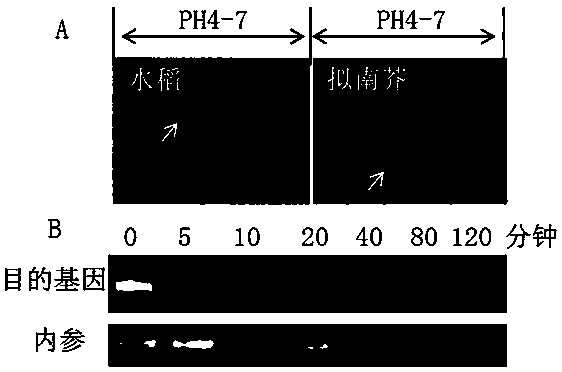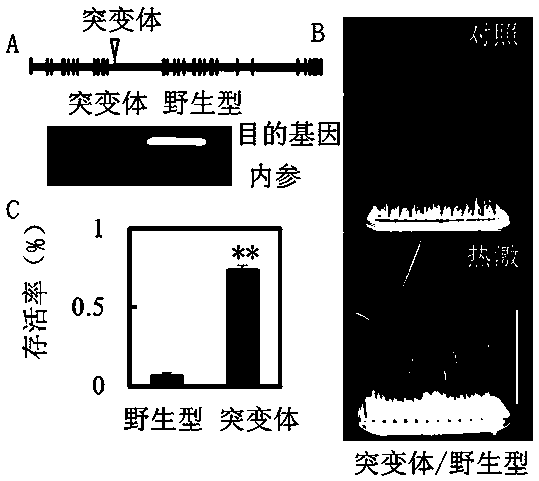Application of paddy rice heat sensitive gene UBP21
A heat-sensitive gene and rice technology, applied in the field of genetic engineering, can solve the problems of unclear heat resistance of deubiquitinated proteins, etc., to improve heat resistance, heat resistance and drought tolerance, and drought tolerance Effect
Inactive Publication Date: 2015-11-11
HEBEI NORMAL UNIV
View PDF4 Cites 5 Cited by
- Summary
- Abstract
- Description
- Claims
- Application Information
AI Technical Summary
Problems solved by technology
It has been confirmed that there are E3 proteins involved in heat tolerance in rice, such as HCl, but the role of deubiquitinated proteins in rice heat tolerance is still unclear
Method used
the structure of the environmentally friendly knitted fabric provided by the present invention; figure 2 Flow chart of the yarn wrapping machine for environmentally friendly knitted fabrics and storage devices; image 3 Is the parameter map of the yarn covering machine
View moreImage
Smart Image Click on the blue labels to locate them in the text.
Smart ImageViewing Examples
Examples
Experimental program
Comparison scheme
Effect test
Embodiment
the structure of the environmentally friendly knitted fabric provided by the present invention; figure 2 Flow chart of the yarn wrapping machine for environmentally friendly knitted fabrics and storage devices; image 3 Is the parameter map of the yarn covering machine
Login to View More PUM
 Login to View More
Login to View More Abstract
The invention discloses an application of a de-ubiquitinating enzyme UBP21 gene in paddy rice and a method of improving heat resistance of plants by means of the gene. In the invention, the nucleotide sequence of the used paddy rice UBP21 gene is represented as the DNA sequence in the Seq ID No.1 and the amino acid sequence encoded by the gene is represented as the amino acid residue sequence represented in the Seq ID No.2. A test proves that when the gene is knocked-out from paddy rice, the paddy rice is increased in survival rate under a heat shock condition and is increased in expression quantity of a downstream heat shock protein, thereby improving the heat resistance of the plants. The application is important in improvement of heat resistance of crops through molecular breeding.
Description
technical field The invention relates to the application of a heat-resistant and drought-related gene UBP21 in rice. The gene is used to regulate the heat resistance of Arabidopsis thaliana by regulating the changes of downstream heat shock proteins, and belongs to the technical field of genetic engineering. Background technique Ubiquitination plays an important role in cell division, differentiation, endocytosis, hormone regulation and transcriptional regulation. Ubiquitin is a highly conserved polypeptide containing 76 amino acid residues, widely present in eukaryotic cells. The ubiquitin molecule combines with the protein substrate through E1, E2 and E3 to form a recognition signal for degradation by the proteasome. The bound ubiquitin is released from the degraded protein under the action of ubiquitin hydrolase and participates in the cycle. It has been confirmed that there are E3 proteins involved in heat tolerance in rice, such as HCl, but the role of deubiquitinated ...
Claims
the structure of the environmentally friendly knitted fabric provided by the present invention; figure 2 Flow chart of the yarn wrapping machine for environmentally friendly knitted fabrics and storage devices; image 3 Is the parameter map of the yarn covering machine
Login to View More Application Information
Patent Timeline
 Login to View More
Login to View More Patent Type & Authority Applications(China)
IPC IPC(8): C12N15/29C07K14/415
Inventor 汤文强张宝文安志超
Owner HEBEI NORMAL UNIV
Features
- R&D
- Intellectual Property
- Life Sciences
- Materials
- Tech Scout
Why Patsnap Eureka
- Unparalleled Data Quality
- Higher Quality Content
- 60% Fewer Hallucinations
Social media
Patsnap Eureka Blog
Learn More Browse by: Latest US Patents, China's latest patents, Technical Efficacy Thesaurus, Application Domain, Technology Topic, Popular Technical Reports.
© 2025 PatSnap. All rights reserved.Legal|Privacy policy|Modern Slavery Act Transparency Statement|Sitemap|About US| Contact US: help@patsnap.com



